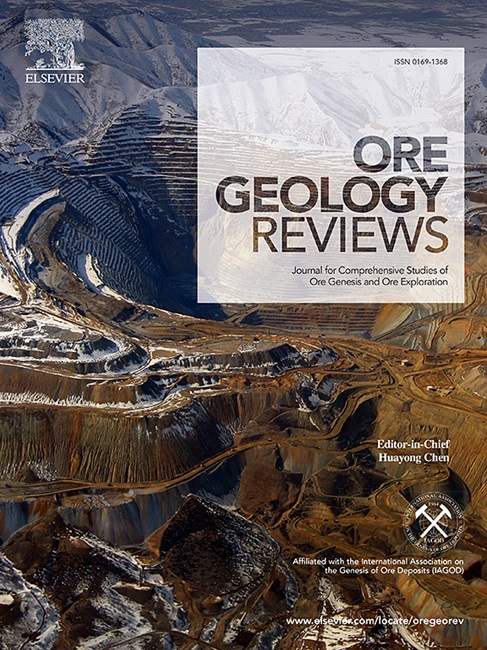华南晚印支期伸展成矿事件:来自浙江直岭头金矿床三叠纪花岗岩的证据
IF 3.6
2区 地球科学
Q1 GEOLOGY
引用次数: 0
摘要
直岭头金矿是中国浙江省唯一的大型金矿床。金矿体赋存于古元古代八渡群黑云母斜长石片麻岩中,未穿透上覆白垩系火山盖层。值得注意的是,该矿床与400 m深处隐伏的黑云母二长花岗岩具有明确的空间关系。本文报道了直岭头地区黑云母二长花岗岩和钾长石花岗岩的锆石U-Pb年龄、地球化学和Sr-Nd-Hf同位素数据。LA-ICP-MS U-Pb锆石分析结果显示,黑云母二长花岗岩和钾长石花岗岩的加权平均年龄分别为230±1 Ma和229±1 Ma。锆石饱和温度的矿物学和地球化学数据表明,这两种岩石类型可划分为铝质-过铝质,属于高钾钙碱性-舒顺质a型花岗岩,与伸展构造环境有关。与钾长石花岗岩相比,黑云母二长花岗岩表现出较低的εHf(t)值和较老的两阶段模式年龄,较高的εNd(t)值和较年轻的TDM2 (Nd)年龄。这些发现表明,这两种岩石类型可能来自混合来源,主要来自下地壳晚古元古代基底的部分熔融。区内a型花岗岩形成于碰撞后伸展构造环境,是三叠纪华南、印支和华北地块碰撞后形成的。地壳伸展减薄促进了部分熔融,有利于花岗岩的形成,为金成矿系统的演化创造了有利条件。本文章由计算机程序翻译,如有差异,请以英文原文为准。

Late Indosinian extensional metallogenic events in South China: Evidence from Triassic granites of the Zhilingtou gold deposit in Zhejiang province
The Zhilingtou gold deposit represents the sole large–scale gold deposit in Zhejiang Province, China. The gold orebodies are hosted within the Paleoproterozoic Badu Group biotite–plagioclase gneiss without penetrating the overlying Cretaceous volcanic cover. Notably, the deposit has a well–defined spatial relationship with the concealed biotite monzogranite at a depth of 400 m. Here, we report zircon U–Pb ages, geochemical and Sr–Nd–Hf isotope data for the biotite monzogranite and K–feldspar granite of the Zhilingtou area. LA–ICP–MS U–Pb zircon analyses provide weighted mean ages of 230 ± 1 Ma and 229 ± 1 Ma for the biotite monzogranite and the K–feldspar granite, respectively. Mineralogical and geochemical data regarding zircon saturation temperatures indicate that these two rock types can be classified as metaluminous to peraluminous and are categorized within the high–K calc–alkaline–shoshonite A–type granites, which are associated with an extensional tectonic environment. The biotite monzogranite exhibits lower εHf(t) values and older two-stage model ages, higher εNd(t) values and younger TDM2 (Nd) ages than the K–feldspar granite. These findings suggest that both rock types likely originated from mixed sources, primarily from the partial melting of a late Paleoproterozoic basement in the lower crust. The A-type granites in the region formed in a post-collisional extensional tectonic environment, emerged after the collision of the South China, Indosinian, and North China blocks during the Triassic period. The resultant crustal extension and thinning facilitated partial melting, which was instrumental in the formation of the granites and established conducive conditions for the evolution of the gold metallogenic system.
求助全文
通过发布文献求助,成功后即可免费获取论文全文。
去求助
来源期刊

Ore Geology Reviews
地学-地质学
CiteScore
6.50
自引率
27.30%
发文量
546
审稿时长
22.9 weeks
期刊介绍:
Ore Geology Reviews aims to familiarize all earth scientists with recent advances in a number of interconnected disciplines related to the study of, and search for, ore deposits. The reviews range from brief to longer contributions, but the journal preferentially publishes manuscripts that fill the niche between the commonly shorter journal articles and the comprehensive book coverages, and thus has a special appeal to many authors and readers.
 求助内容:
求助内容: 应助结果提醒方式:
应助结果提醒方式:


